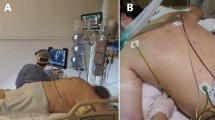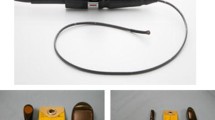Abstract
Objective
Patients with severe acute respiratory distress syndrome (ARDS) often require prolonged sessions of prone position (PP) because of refractory hypoxemia. Because of frequent hemodynamic impairment, use of transesophageal echocardiography (TEE) is also advocated during ARDS, but its implementation during PP has not been described yet. Our objective is to report the feasibility, tolerance, and therapeutic implications of TEE during PP for severe ARDS, and to compare it with TEE performed supine.
Methods
Prospective study in the medical intensive care unit of a university hospital.
Results
A total of 34 patients with ARDS underwent TEE in PP. Probe insertion was successful in all but one patient, and vital signs did not change during insertion. All standard views and measures could be obtained, except for patent foramen ovale in one patient, and cardiac output assessment in four patients. TEE examinations were all conclusive and led to therapeutic change proposal in 23 patients (70%). TEE was performed in both supine and PP in 16 patients within a median delay of 3 days. There was no difference between the two examinations in terms of feasibility, tolerance, therapeutic implication, and image quality. In ten healthy individuals, we also explored the minimal cross-sectional area of the oropharyngeal duct with the acoustic reflection technique; it was found identical in supine and PP.
Conclusions
TEE can be performed safely and efficiently in severe ARDS patients in PP. PP is not associated with a significant change in the oropharyngeal tract cross-section in healthy individuals.

Similar content being viewed by others
References
Vieillard-Baron A, Schmitt JM, Augarde R, Fellahi JL, Prin S, Page B, Beauchet A, Jardin F (2001) Acute cor pulmonale in acute respiratory distress syndrome submitted to protective ventilation: incidence, clinical implications, and prognosis. Crit Care Med 29:1551–1555
Mekontso Dessap A, Charron C, Devaquet J, Aboab J, Jardin F, Brochard L, Vieillard-Baron A (2009) Impact of acute hypercapnia and augmented positive end-expiratory pressure on right ventricle function in severe acute respiratory distress syndrome. Intensive Care Med 35:1850–1858
Vieillard-Baron A, Charron C, Chergui K, Peyrouset O, Jardin F (2006) Bedside echocardiographic evaluation of hemodynamics in sepsis: is a qualitative evaluation sufficient? Intensive Care Med 32:1547–1552
Sud S, Friedrich JO, Taccone P, Polli F, Adhikari NK, Latini R, Pesenti A, Guerin C, Mancebo J, Curley MA, Fernandez R, Chan MC, Beuret P, Voggenreiter G, Sud M, Tognoni G, Gattinoni L (2010) Prone ventilation reduces mortality in patients with acute respiratory failure and severe hypoxemia: systematic review and meta-analysis. Intensive Care Med 36:585–599
McAuley DF, Giles S, Fichter H, Perkins GD, Gao F (2002) What is the optimal duration of ventilation in the prone position in acute lung injury and acute respiratory distress syndrome? Intensive Care Med 28:414–418
Bernard GR, Artigas A, Brigham KL, Carlet J, Falke K, Hudson L, Lamy M, Legall JR, Morris A, Spragg R (1994) The American–European Consensus Conference on ARDS. Definitions, mechanisms, relevant outcomes, and clinical trial coordination. Am J Respir Crit Care Med 149:818–824
Mercat A, Richard JC, Vielle B, Jaber S, Osman D, Diehl JL, Lefrant JY, Prat G, Richecoeur J, Nieszkowska A, Gervais C, Baudot J, Bouadma L, Brochard L (2008) Positive end-expiratory pressure setting in adults with acute lung injury and acute respiratory distress syndrome: a randomized controlled trial. JAMA 299:646–655
Cohen GI, Davison MB, Klein AL, Salcedo EE, Stewart WJ (1993) The frequency of acquisition and quality of images obtained by transesophageal echocardiography: a prospective study of 100 consecutive cases. J Am Soc Echocardiogr 6:577–582
Louis B, Glass G, Kresen B, Fredberg J (1993) Airway area by acoustic reflection: the two-microphone method. J Biomech Eng 115:278–285
Mohsenin V (2001) Gender differences in the expression of sleep-disordered breathing: role of upper airway dimensions. Chest 120:1442–1447
Ohmae Y, Ogura M, Kitahara S, Karaho T, Inouye T (1998) Effects of head rotation on pharyngeal function during normal swallow. Ann Otol Rhinol Laryngol 107:344–348
Tsubo T, Yatsu Y, Tanabe T, Okawa H, Ishihara H, Matsuki A (2004) Evaluation of density area in dorsal lung region during prone position using transesophageal echocardiography. Crit Care Med 32:83–87
Vignon P, Mentec H, Terre S, Gastinne H, Gueret P, Lemaire F (1994) Diagnostic accuracy and therapeutic impact of transthoracic and transesophageal echocardiography in mechanically ventilated patients in the ICU. Chest 106:1829–1834
Huttemann E (2006) Transoesophageal echocardiography in critical care. Minerva Anestesiol 72:891–913
Chino JP, Marks LB (2008) Prone positioning causes the heart to be displaced anteriorly within the thorax: implications for breast cancer treatment. Int J Radiat Oncol Biol Phys 70:916–920
Acknowledgments
Support was provided solely from institutional and departmental sources.
Author information
Authors and Affiliations
Corresponding author
Electronic supplementary material
Below is the link to the electronic supplementary material.
Rights and permissions
About this article
Cite this article
Mekontso Dessap, A., Proost, O., Boissier, F. et al. Transesophageal echocardiography in prone position during severe acute respiratory distress syndrome. Intensive Care Med 37, 430–434 (2011). https://doi.org/10.1007/s00134-010-2114-z
Received:
Accepted:
Published:
Issue Date:
DOI: https://doi.org/10.1007/s00134-010-2114-z




